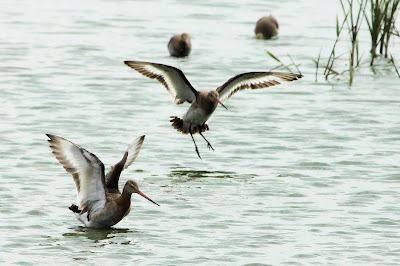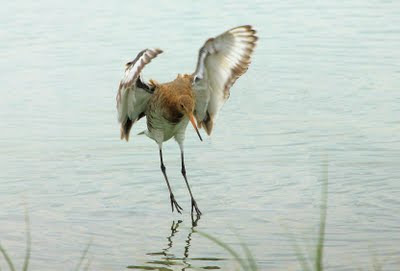23 May 2011
22 May 2011
17 May 2011
Pleasant morning at RSPB Elmley
A nice morning on Elmley reserve yesterday 16-5-2011 a cool wind kept temperatures down but it did not spoil a good morning,.
I can also report good numbers of Marsh Harrier, eight in all seen from the Wellmarsh hide.
A lone Spoonbill in flight at distance, and I can report that I saw a single Spoonbill on Grain marshes, possibly one of the three that seem to have taken to this area, perhaps even joining the Heron and Egrets at Northward Hill.
A pair of Redshank
A nice shot of these birds its all about composition and not just getting a record shot with the subject bang in the middle.
Meadow or Tree Pipit ?
I have researched my books and enlisted the help of the web as to which of the two this bird is, I have come to the conclusion that it could be a tree pipit, the eye stripe is more prominent in the tree and the beak a little heavier which they are.
Some not so usual pictures of Black Tailed Godwits
BT Godwits settling after being disturbed by a marauding Marsh Harrier, it made a very pleasing composition.
8 May 2011
Legal battle for bumblebee paradise
Buglife - The Invertebrate Conservation Trust is fighting to protect a wildlife haven on the Isle of Grain in Kent from a huge National Grid warehouse development. This bug paradise is home to a variety of beautiful, rare and endangered insects including a large population of threatened bumblebee species.
The Isle of Grain Hoo Peninsular, Kent, supports an exceptional area of Open Mosaic Habitat providing lots of pollen and nectar rich flowers, bare ground ideal for burrowing and basking insects and pools for aquatic beetles and bugs - a similar habitat to West Thurrock Marshes, a key wildlife site that Buglife fought to save in 2008The Isle of Grain is home to an array of special plants, reptiles, bumblebees, hoverflies and beetles. Important bumblebees present include the Brown banded carder-bee (Bombus humilis) and Shrill carder-bee (Bombus sylvarum). Also living on the Open Mosaic Habitat are the White eye-stripe hoverfly (Paragus albifrons), which until recently was believed to be extinct, and Mellet's downy-back beetle (Ophonus melletii), which is so rare that it has only been seen five times in the UK in the last 20 years.
Matt Shardlow, Buglife Chief Executive said 'The Isle of Grain is likely to be one of the most important sites in Britain for rare and endangered invertebrates. This is a bug paradise and National Grid's current plans to develop it into a huge business park and lorry depot would destroy it.'
National Grid has already sprayed large areas of the site with pesticides, justifying this as an attempt to eliminate Brown-tail moths. This has resulted in the loss of flowering plants and bushes used by pollinating insects such as bumblebees White eye-stripe hoverfly (Paragus albifrons) (c) Mikel Tapia Arriada
Buglife have started a legal battle on behalf of the invertebrates inhabiting the site. In the first round of legal proceedings the judge agreed with Buglife that National Grid and Medway Council had failed to properly assess the impact on the wildlife of the site. The Judge concluded that National Grid must stop spraying the site with pesticides and allow the ecology to recover before undertaking further surveys to find out exactly how important the wildlife is. Despite the judge's support of Buglife's arguments he refused to allow Buglife to judicially review the planning permission.
Matt Shardlow responded 'We are pleased that the judge recognised the ecological importance of National Grid's land, and highlighted that the planning process has not
properly considered its importance, but we are not convinced that the proposal to just do more ecological assessments will save the animals. Buglife is appealing this decision; that is the right thing to do for the bumblebees and to ensure that future generations of people will benefit from the bee's diligent work pollinating flowers and crops'.
Dr. Ben Darvill, Director of the Bumblebee Conservation Trust said "The Thames Gateway is of national importance for rare bumblebees with populations hanging on in flower-rich pockets of habitat. The Isle of Grain is a very important site and if it is destroyed or degraded the whole population structure could collapse."
Buglife - The Invertebrate Conservation Trust is the only charity in Europe devoted to the conservation of all invertebrates, and is actively working to save Britain's rarest bugs, bees, butterflies, ants, worms, beetles, snails and many more fascinating invertebrates. Further information is available on Buglife's website at www.buglife.org.uk
.The site is 164 hectares in total; over 100 hectares of important habitat for rare and endangered invertebrates will be destroyed or degraded by the development. The development has not been designed to avoid the most valuable areas open mosaic habitat.Normally one would expect several weeks of survey work on an area of this potential significance .A one day survey as part of the Environmental Impact Assessment found an outstanding 258 species; 13 of which are Red Data Book, 23 Nationally scarc, 4 have UKBAP status and 11 are to beof rare or accasional occurrance.
The East Thames Corridor region currently supports one of the most important remaining metapopulations of the Brown banded carder-bee (Bombus humilis) and Shrill carder-bee (Bombus sylvarum) in the UK, but many sites are already lost or under direct threat of development. Bumblebee populations appear to operate at a landscape scale and it is probable that viable individual populations require minimum ranges of between ten to twenty km2 of good matrix habitat, including several large patches of flowers within these range areas. A thriving population of bumblebees will require dozens of active nests and tens of hectares of suitable habitat.
Mellet's Downy-back beetle (Ophonus melletii) is a UKBAP priority species. This beetle has declined more than 50% over the last 25 years, and there have only been five records in the last 20 years, one of which was from Rochester (N Kent), finding this beetle on site is very significant.
White eye-stripe hoverfly (Paragus albifrons) is a very rare species. Hoverfly experts were poised to declare this species as extinct, but it is now known to survive on two brownfield sites in the Thames Gateway. The ecological requirements of this species are not fully understood.
Subscribe to:
Posts (Atom)
















